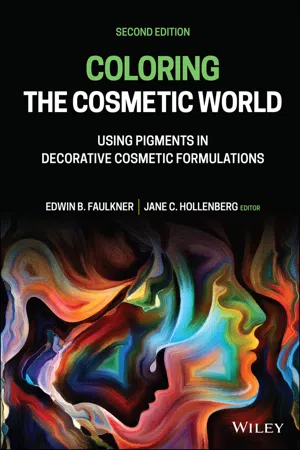
Coloring the Cosmetic World
Using Pigments in Decorative Cosmetic Formulations
- English
- ePUB (mobile friendly)
- Available on iOS & Android
Coloring the Cosmetic World
Using Pigments in Decorative Cosmetic Formulations
About this book
A comprehensive resource on the regulations, applications, properties and processing of pigments used in color cosmetics, now in its second edition.
Coloring the Cosmetic World is a highly practical guide to colorant selection for product formulations in the modern cosmetics and toiletries industry. Providing the essential knowledge required to successfully incorporate pigments into cosmetic formulations, this unique resource covers all essential aspects of color selection—including regulations, economics, color esthetics, and stability—as well as processing, color measurement, pigment testing, natural colorants, and more. This new edition contains carefully revised content and includes updated coverage of economic and regulatory criteria.
Drawing upon their decades of experience in the color industry, the author and editor focus on the specific color additives that are approved for use in cosmetics formulations. The book's twelve in-depth chapters include full masstone representations of numerous pigments to help readers appreciate subtleties and differences in absorption pigments, effect pigments, specialty pigments, and others. Appendices contain various pigment test methods, a glossary, and an up-to-date listing of treated pigment patents. Covering the chemistry, regulations, evaluation, processing, and properties of worldwide cosmetic pigments, this one-of-a-kind book:
- Covers the common pigments used in lipsticks, face makeup, eye shadow, mascara, nail lacquer, and other color cosmetics
- Provides detailed information on a variety of specific pigments, including their chemical properties, esthetic quality, and application in a wide range of products
- Discusses regulatory considerations and the economics of selecting colors for use in different decorative cosmetics
- Highlights practical concerns such as colorants' stability, interactions with other chemicals, manufacturing conditions, and packaging
- Explains how the effects of heat, light, pH, humidity, and other environmental factors inform pigment selection for different product types and use cases
Coloring the Cosmetic World: Using Pigments in Decorative Cosmetic Formulations, Second Edition, is an indispensable guide for cosmetic chemists, a useful reference for purchasing agents, supply coordinators, and marketers working in the cosmetics industry, and a valuable supplementary text for undergraduate and graduate university programs in the field.
Frequently asked questions
- Essential is ideal for learners and professionals who enjoy exploring a wide range of subjects. Access the Essential Library with 800,000+ trusted titles and best-sellers across business, personal growth, and the humanities. Includes unlimited reading time and Standard Read Aloud voice.
- Complete: Perfect for advanced learners and researchers needing full, unrestricted access. Unlock 1.4M+ books across hundreds of subjects, including academic and specialized titles. The Complete Plan also includes advanced features like Premium Read Aloud and Research Assistant.
Please note we cannot support devices running on iOS 13 and Android 7 or earlier. Learn more about using the app.
Information
Chapter 1
Color Basics
It's a Colorful World
Table of contents
- Cover
- Table of Contents
- Title Page
- Copyright
- Author's Biography
- About the Editor
- Preface
- Acknowledgments
- Introduction
- Chapter 1: Color Basics
- Chapter 2: Color Selection – Regulations
- Chapter 3: Color Selection – Stability
- Chapter 4: Color Selection – Color Esthetics
- Chapter 5: Color Selection – Economics
- Chapter 6: Pigment Dispersion
- Chapter 7: Color Measurement and Pigment Testing
- Chapter 8: Surface Treated Pigments
- Chapter 9: Effect Pigments
- Chapter 10: Specialty Pigments
- Chapter 11: Natural Colorants
- 12 Some Slices of Life
- Appendix A: Pigment Test Methods Courtesy of Sun Chemical Corp.
- Appendix B: Treated Pigment Patents
- Glossary of Terms
- Further Reading
- Index
- End User License Agreement